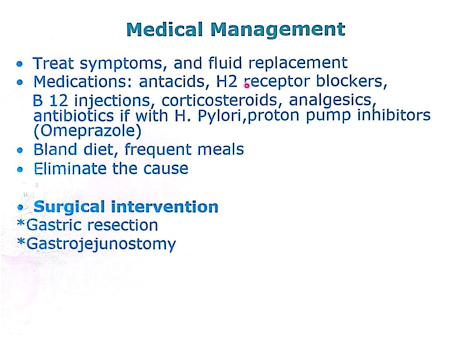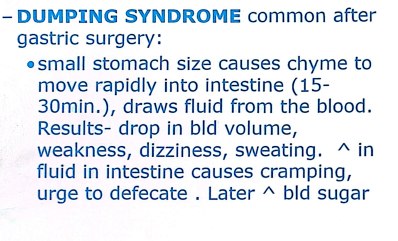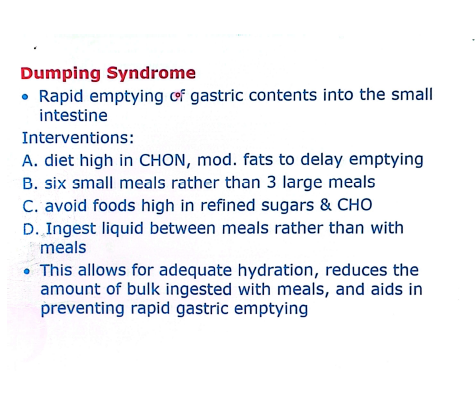Disorders of Digestion and Absorption
1/36
There's no tags or description
Looks like no tags are added yet.
Name | Mastery | Learn | Test | Matching | Spaced |
|---|
No study sessions yet.
37 Terms
nausea and vomiting
unpleasant sensation usually preceding vomiting, may have abdominal pain, pallor, sweating, clammy skin
vomiting
forceful expulsions of stomach contents throught the mouth
projectile vomiting
is forceful ejection of stomach contents
regurgitation
gentle ejection of stomach contents without nausea or retching
antiemetics
IV Fluids
NG tube
TPN
treatments for nausea and vomiting
dehydration
metabolic alkalosis
aspiration
complications of nausea and vomiting:
hiatal hernia
opening in the diaphragm thru w/c the esophagis passes becoms enlarged and part of the upper stomach moves up into the lower portion of the thorax
occurs more often in women than in women
hiatal hernia
it is caused by the lower esophageal sphincter related to increased abdominal pressure, long term bed rest, trauma
type 1: sliding
occurs when the upper stomach and the gastroesophageal junction are dislplaced upward and slide in and out of the thorax
type 2: rolling / PARAESOPHAGEAL
occurs when all or part of the stomach pushes through the diaphragm beside the esophagus
further classified as types II, III, IV
2 types of hiatal hernia
type 1: sliding
what type of hiatal hernia: occurs when the upper stomach and the gastroesophageal junction are dislplaced upward and slide in and out of the thorax
type 2: rolling / PARAESOPHAGEAL
what type of hiatal hernia:
occurs when all or part of the stomach pushes through the diaphragm beside the esophagus
further classified as types II, III, IV
type 1: sliding type
what type of hiatal hernia:
dysphagia
regurgitation
heartburn (pyrosis)
intermittent epigasruc pain or fullness after eating
hemorrhage, obsyruction and strangulation can occur with any type of hernia
type 2: rolling / paraesophageal
what type of hiatal hernia:
sense of fullness or chest pain after eating

disgnostics of hiatal hernia:
esophagogastroduodonescopy
what is EGD (it is for hiatal hernia)
small freq feedins
not to recline for q hour after eating
elevate head of bed on 4 to 8 inch blocks
what should be considered for hiatal hernia:
h2 receptor antagonists: to reduce stomach secretion
tagamet
zantac
pepsid
antacids: neutralize stomach acids
reglan, propulsid: increase stomach emptying
drug theraoy for hiatal hernia:
decrease caffeine, fatty foods, alcohol, acidic and spicy foods, avoiding bedtime snack
diet therapy for hiatal hernia:
fundoplication
stomach fundus is wrapped around the lower part of the esphagus
gastritis
inflammation of the gastric or lining of the stomach (mucosa)
acute
what type of gastritis: lasting several hours to a few days; may develop in acute illnesses
chronic
a type of gastritis that is from repeated exposure to irritating agents or recurring episodes of acute gastritis
erosive, non-erosive
acute gastritis can be classified as:
erosive
what type of acute gastritis: caused by local irritants such as aspirin and other NSAIDS, alcohol abuse and recent exposure o radiation therapy
this type of acute gastritis is most often caused by infection with helicobacter pylori
more severe form
caused by indigestion of strong acid or alkali
may also develop in acute illlnesses (burns, severe infetion, hepatic, kidney or respi failure)
type a (autoimmune disorders)
type b (underlying causative mechanism)
chronic gastritis is classified to:
hashimoto thyroiditis
addison’s disease
grave’s disease
type a chronic gastritis disorders:
h. pylori
long term drug therapy
reflux of duodenal contents into the stomach
type b chrnoic gastritis disorders:
acute
acute or chronic gastritis:
epigastric pain or discomfort
dyspepsia
ausea and vomiting
anorexia
hiccups
bleeding (hematemesis, melena, hematochezia)
chronic
acute or chronic gastritis:
anorexia
heartbirn after eating
belching
sour taste in the mouth
nausea and vomiting
early satiety
vit. b12 deficiency (pernicious anemia)
poor absorption of certain vitamin in chronic gastritis can lead to:
endoscopy
definitive diagnosis of gastritis

medical management of gastritis:
dumping syndrome
this is common after gastric surgery:

dumping syndrome
dumping syndrome
rapid emptying of gastric contents into the small intestine

interventions on dumping syndrome: